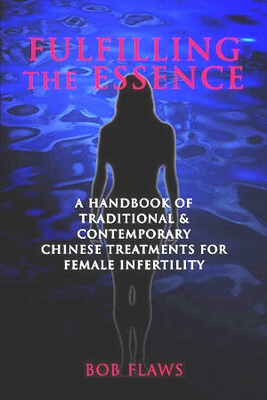Acupuncture and TCM Books
Fulfilling the Essence:
Traditional & Contemporary Chinese Treatments for Female Infertility
DESCRIPTION: This book is another in Bob Flaws' series on gynecology. It is the most complete discussion of Chinese medicine on this subject available in English. It includes the TCM treatment for various Western diseases associated with infertility, including female immunologic infertility, fallopian tube blockage, endocrine imbalances, polycystic ovarian syndrome, uterine myoma, luteal phase defect, anovulation, and endometriosis.
Modern Western Medicine & Infertility
Eighty percent of couples having regular sex without contraception will conceive within one year with another 10% conceiving after that. This suggests that around 10% of the population suffers from infertility. Of this number, 40% is due to female problems, 40% to male problems, and 10% to a combination of both acting synergistically. Peak fertility seems to occur between 21-25 years of age in both males and females after which it gradually declines. After 25 years of age, there is a 75% chance of pregnancy within 6 months. Approaching 30, this decreases to only a 47% chance. Approaching 40, this further decreases to only a 25% chance, and after 40 to a 22% chance. Another way of stating these statistics is that a woman's risk of infertility is 2 times greater in women between 35 and 44 than in women between 30 and 34. It also seems that the risk of infertility is 1½ times higher for African Americans than for whites. In China, primary infertility is defined as failure to conceive after two years of having regular sex without contraception. Secondary infertility refers to a woman who is not able to conceive for two years of unprotected sex but who previously has been pregnant at least once.
The Menstrual Cycle
For the purposes of this book and based on the Chinese infertility literature, we will divide the menstrual cycle into four phases. These we will refer to as phase I, the proliferative phase; phase II, the ovulatory phase; phase III, the postovulatory or luteal phase; and phase IV, menstruation. Modern Western reproductive endocrinology only recognizes three phases to the menstrual cycle. In this case, the preovulatory follicular phase of Western medicine includes menstruation itself and the endometrial proliferation phase.
When counting the days of the menstrual cycle, one always begins with the onset of normal bleeding. This becomes day 1 and every subsequent day until the onset of the next period is counted from there. Therefore, for the purposes of this book, phase I refers to the 6-10th days of the cycle; phase II to the 11-16th days; phase III to the 17-28th days; and phase IV to the 1-5th days.
Beginning on day 1, the first day of normal menstruation, luteinizing hormone-releasing factor (LHF) is secreted by the hypothalamus. This stimulates the anterior pituitary to secrete follicle-stimulating hormone (FSH). This hormone then stimulates the ovaries to develop the growth of a cohort of between 3 and 30 follicles consisting of oocytes and their surrounding cells. One to two days later, the same LHF from the hypothalamus stimulates the anterior pituitary to release luteinizing hormone (LH). These two hormones, FSH and LH, stimulate the growth and development of one of the oocytes into an ovum or egg. The other oocytes degenerate and typically fail to produce a mature egg.
Around day 5 or so and corresponding to roughly the end of the period, estrogen and particularly estradiol or E2 secreted from the ovaries begins to increase. This estradiol stimulates progressive proliferation of the endometrial lining, thus preparing the uterus for the implantation of a fertilized ovum. Because of this, the Chinese literature refers to phase I as the proliferative phase. This proliferative phase stimulated by estrogen production and release corresponds to our phase I.
In phase II or the ovulatory phase, estrogen levels continue to rise and then accelerate and peak just before there occurs a massive, preovulatory surge of LH by the pituitary gland. In turn, just before this LH surge, progesterone secreted by the ovaries also begins to increase significantly. At roughly the same time, FSH levels decrease. The LH surge usually lasts from 36-48 hours and is composed of several large bursts of LH release. This causes the mature ovum to be released by the ovary some time 16-32 hours after the onset of this surge.
In phase III, the luteal phase, the corpus luteum of the ovary formed from the site where the ovary was released itself releases progesterone. The endometrium, under the influence of this progesterone becomes increasingly vascularized. During this time, the ovum is traveling through the fallopian tubes towards the uterus. If this ovum becomes fertilized, it will attach itself to the walls of the endometrium. However, if it does not, both E2 and progesterone decline during the later stages of phase III and the endometrium becomes increasingly edematous. Eventually the endometrial stroma become necrotic and the endometrial lining is sloughed. This is accompanied by endometrial bleeding and the period begins. Thus begins phase IV and this cycle repeats itself with a rise in LH and FSH.
Thus it can be seen from the above brief outline of female reproductive endocrinology that normal reproductive function requires a complex interplay of endocrine glands secreting hormones which then have an effect on target organs in the body. Although the pituitary gland appears to be the central command post orchestrating this complex interplay, in fact, the pituitary itself is, among other factors, affected by mental/emotional events. Cerebral cortical function can, via the hypothalamus, have an impact on pituitary function and, therefore, reproductive endocrine secretions. Likewise, diet can have a large impact on reproductive humors....
 Fulfilling the Essence:
Fulfilling the Essence: